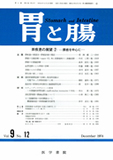Japanese
English
- 有料閲覧
- Abstract 文献概要
- 1ページ目 Look Inside
近年,膵癌の早期発見が叫ばれるようになり,積極的な開腹診断の必要性が強調されるにつれ,術中診断法として膵生検が注目されるようになった.しかるに,従来より行なわれてきたincisional biopsyやneedle biopsyは診断信頼性,合併症,手術時間の延長などの点で充分に満足できるものではなかった.一方,乳腺,甲状腺などの表在性臓器に対するaspiration biopsyが確立されるとともに,膵に対しても術中aspiration biopsy(fine needle aspiration biopsy)が試みられるようになった.
われわれも,昭和44年以来,膵癌や慢性膵炎に対して積極的に施行し,その有用性についてはしばしば報告してきた1)3)4).さらに,昭和47年,これら術中膵aspiration biopsyで得た成績をもとに消化管fiberscopeを利用して,開腹を要せず施行可能な膵aspiration biopsy(非手術的膵aspiration biopsy)を開発した.膵頭部,あるいは膨大部穿刺にはfiberduodenoscopeを用いた経十二指腸的膵頭部aspiration biopsy(FDS-Asp.Bx.と略)を,膵体尾部穿刺にはfibergastroscopeを利用した経胃的膵体尾部aspiration biopsy(GFB-Asp.Bx.と略)を行なっている.
The purpose of this paper is to investigate the value of cytologic examination of the aspiration biopsy of the pancreas during operation and without surgery, and to present a new technique using a fiberscope.
1. Peroperative aspiration biopsy of the pancreas during operation
The aspirations were performed with a 5 cc ordinary syringe equipped with a 22 gauge fine needle.
The cytologic examination of aspiration biopsy in the pancreatic region has been in 46 patients with malignancy and in 76 patients with benign lesions, such as chronic pancreatitis and induration of the pancreatic head secondary to cholelithiasis, during operation from September 1969 to July 1974.
In 44 of 46 cancer patients, cytological diagnosis was positive for malignancy. Eight patients had false negative diagnoses on the incisional biopsies out of 44 patients with positive cytological diagnosis confirmed by aspiration biopsy.
A suspicion of cancer was entertained in the remaining 2 patients, both of which were misdiagnosed due to technical inadvertence.
There were no false negative cytological diagnoses in the cancer group. In 76 patients with benign pancreatic lesions, however, false positive cytological diagnoses were made in 2 patients with pancreatolithiasis. These false positive diagnoses were due to misjudgement of the dysplastic cells, which were occasionaly seen in chronic pancreatitis. No complications such as bleeding, acute pancreatitis and pancreatic fistula were observed in any cases.
2. Transduodenal and transgastric aspiration biopsy of the pancreas without surgery
The non-surgical biopsy of the pancreas has been regarded almost impossible, because of its anatomical location in the retroperitoneal cavity. The fiberscope, however, made it possibe to approach to the pancreas via the duodenum and stomach.
In October 1972, the authors developed a new technique of non-surgical aspiration biopsy of the pancreas using a fiberscope with a specially designed fine needle.
The tissue of the pancreatic head and the periampullary region was obtained through the duodenal wall for the transduodenal aspiration biopsy, which was performed with a fiberduodenoscope equipped with 6 mm long, 26 gauge needle.
The transgastric aspiration biopsy was suitable for the cellular matrial of the body and of the tail of the pancreas.
The non-surgical transgastric aspiration biopsy was done with a fibergastroscope, which had a 7 mm long, 23 gauge needle. From October 1972 to July 1974, the non-surgical transduodenal aspiration biopsy has been performed in 13 patients with carcinoma of the pancreas and the periampullary region and in 20 patients with benign diseases of pancreas and duodenum.
Of 13 cancer patients, malignant cells were cytologically identified in 7 patients (3 of carcinoma of the pancreatic head, 2 of periampullary carcinoma, 1 of carcinoma of the diffuse pancreas, 1 of carcinoma of the peripancreatoduodenal region).
Suspicious cells were present in 1 of periampullary carcinoma. In the remaining 5 patients, the cytological diagnoses were negative for cancer. In 3 of 5 patients with false negative diagnosis, the technique was not sufficient to reveal malignant cells originating from carcinoma of the body and tail of pancreas, because the biopsy needle could not reach the lesions, There were no false positive diagnoses in 20 patients with benign lesions. In 8 patients with malignancy (4 of carcinoma of the body and tail of pancreas, 4 of carcinoma of the diffuse pancreas) who underwent the non-surgical transgastric aspiration biopsy malignant cells were present on cytologic examination in all patients. Also 3 patients with chronic pancreatitis had the same procedure biopsy. There was no false positive diagnosis.
The new technique of aspiration biopsy was not followed by serious complications such as acute pancreatitis, leakage of pancreatic juice or bleeding.

Copyright © 1974, Igaku-Shoin Ltd. All rights reserved.


